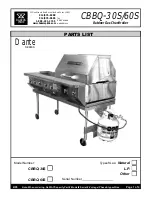
Page 81
gas valves to the appliance. Remove the front door to
the appliance and the plastic bezel and the control panel.
Remove all wire connections from the control board.
The control board connections are keyed to only allow
connection in the proper location, but proper handling
techniques should be used to avoid damage to the wiring
or connectors. To remove the control, push in on the
two tabs on the left side of the board to unlatch the clips
from the control panel. Rotate the control around the
fastening points on the right side of the control to remove
the hooks from the control panel. To replace the control,
repeat the steps listed above in the reverse orders
making sure to connect all wires in the proper locations.
Place the appliance in operation following the steps
outlined in Section 9.
Ignitor Assembly
The ignitor assembly is a two rod system that consists
of a ground rod and a spark rod (See Figure 47). To
remove the ignitor assembly, shut off the 120 Volt
power supply to the appliance. Turn off all manual
gas valves connecting the appliance to the main gas
supply line. Remove the front door of the boiler to gain
access to the ignitor assembly. Remove the two wires
connected to the assembly. Then remove the two bolts
connecting the ignitor assembly to the burner door. If
the old ignitor assembly is determined to be defective,
install a new ignitor assembly (check that the spark gap
is 3/16”). Replace the gasket if necessary.
Flame Sensor
The flame sensor is a single rod system. To replace
the flame sensor electrode, shut off the 120 Volt power
supply to the boiler. Turn off all manual gas valves
connecting the boiler to the main gas supply line.
Remove the front door of the boiler to gain access to
the flame sensor electrode. Remove the flame sensor
wire from the electrode. Remove the two bolts fastening
the electrode to the burner doors. Remove and replace
the old flame sensor gasket. If the old electrode is
determined to be defective, install a new flame sensor
electrode in the reverse order.
Caution
The ignitor and sensor may be hot, and can cause
burns or injury.
Transformer with Integral Circuit Breaker
The appliance has a 24Vac transformer with integral
4 amp circuit breaker installed to supply the control
voltage required for the appliance. The transformer is
sized to provide power for the unit only, and should not
be used to supply power to additional field devices. If
additional loads are added, or a short occurs during
installation, the integral circuit breaker may trip. If this
happens, be sure to reset the circuit breaker before
replacing the transformer.
The transformer is mounted underneath the control
panel. If the transformer must be replaced, turn off the
120Vac power to the appliance. Remove the transformer
wires from the terminal blocks. Remove the fasteners
holding the transformer, then remove the transformer.
Replace with a new transformer in the reverse order.
If the transformer is replaced with a part other than the
OEM transformer, be sure to add circuit protection if it is
not integral to the new transformer.
WARNING
Failure to include proper circuit protection may lead to
premature component failure, fire, injury or death.
Blower
The combustion air blower is a high-pressure centrifugal
blower with a variable speed motor. The speed of the
motor is determined by the control logic. 120 Volt power
remains on to the blower at all times. If the blower
must be changed, turn off the 120 Volt power and gas
supply to the unit. Take the front panel off. Disconnect
the 120 Volt and control signal connections from the
blower. Disconnect the bolts connecting the Venturi to
the blower housing. Disconnect the fan outlet bolts from
the burner door blower arm. If the fan is determined to
be defective, replace the existing fan with a new one,
reversing the steps listed above. Be sure to install all of
the required O-rings and gaskets between the blower
arm and the blower and blower face and venturi flange.
Heat Exchanger Coils
Black carbon soot buildup on the heat exchanger is
caused by one or more of the following; incomplete
combustion, combustion air problems, venting problems,
or heater short cycling. Soot buildup or other debris on
the heat exchanger may restrict the flue passages.
If black carbon soot buildup on the heat exchanger is
suspected, disconnect the electrical supply to the unit,
and turn off the gas supply by closing the manual gas
valve on the unit. Access the heat exchanger through
the burner door at the front of the boiler, and inspect the
tubing using a flashlight. If there is a buildup of black
carbon soot or other debris on the heat exchanger, clean
using this procedure:
WARNING
Black carbon soot buildup on a dirty heat exchanger
can be ignited by a random spark or flame. To prevent
this from happening, dampen the soot deposits with
a wet brush or fine water spray before servicing the
heat exchanger.
NOTE: The Warranty does not cover damage caused
by lack of required maintenance, lack of water flow,
or improper operating practices.
N
EO
T
HERM
Commercial Boilers and Water Heaters
Summary of Contents for NEOTHERM NTH
Page 4: ...LAARS Heating Systems ...
Page 36: ...Page 36 Figure 22 Hydronic Piping Single Boiler Zoning with Circulators LAARS Heating Systems ...
Page 52: ...Page 52 Figure 36 Ladder Diagram 7 H Ladder Diagram LAARS Heating Systems ...
Page 100: ...Page 100 Parts Illustration 4 Internal Components Sizes 750 850 LAARS Heating Systems ...
Page 102: ...Page 102 Parts Illustration 6 Gas Train Components Sizes 600 850 LAARS Heating Systems ...
















































